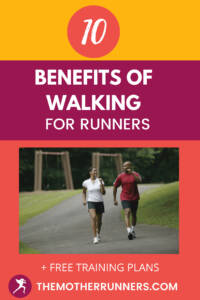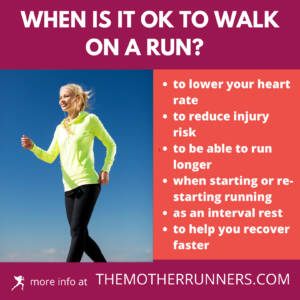For some reason, there is a stigma against walking in the running world. There is this belief that if you walk on your runs, then you aren’t a real runner. But this is false. In fact, there are lots of benefits of walking for runners along with significant health benefits for people in general.
After dealing with running injury after running injury, I firsthand experienced the walking benefits for runners. In fact, when I focused on walking was I finally able to start running again. Yes, being a walker helped me be a runner—a better runner.
Related: Lessons Learned from My Hamstring Injury
And even though I am no longer injured, I still take advantage of the benefits of walking by taking walk breaks during runs to keep myself healthy. I share this with my athletes as many of them feel shame if they take a walk break during a run, including during a long run. But there “ain’t no shame” in the walking game.

I have an exercise physiologist back me up on this. Todd Buckingham, a 2:25 marathoner, is a huge proponent of walking for runners. In fact, he prescribes walk breaks for the athletes he coaches—no matter their experience or talent level. This is because he believes as well that walking can make you a better runner.
Related: How I Stopped Being an Injury Prone Runner
In this article, I will share:
- When it is ok to walk on a run
- When it is NOT ok to walk on a run, and
- 10 walking benefits for runners
So, let’s get into the walking benefits for runners!
When is it ok to walk on a run?
It is ok to walk on a run in a lot of situations. It is ok to walk on a run to:
- Recover
- Lower your heart rate
- Take care of an injury or lower injury risk
- Run on changing terrain
- Warm-up and cool-down
- Run for longer
- Deal with challenging elements like humidity or heat
- Adapt to running as a new runner
If being able to walk helps you keep up your running habit so you can maintain a healthy weight and healthy lifestyle, then for goodness sake, WALK!
Related: Running for Weight Loss: An Expert Guide
When is it not ok to walk on a run?
It is not ok to walk on a run if you trying to build mental stamina or in the middle of a running workout that does not prescribe breaks. For example, is it not ok to stop and walk when you are doing a tempo run.
Related: What is a Tempo Run?
If you must stop and walk during a running workout, it means you are running too fast and need to adjust your paces or run more by effort.
In most cases, it is not okay to walk during a race if you are trying to achieve a goal race time. If you are a run/walker and walking is part of your race plan, then it is okay to walk (of course!). But if your time goal is aggressive and your race pace does not include walk breaks, then it is not ok to walk unless you absolutely have to.

Obviously, if you have intense pain anywhere, then it is important for your health and safety to walk. But if you want to walk during a race simply because you feel uncomfortable, then this is a point to get curious about what lies within and keep going.
Related: Mental Strength Tips for Runners from a Sports Psych
How do I stop walking during my runs?
If you are taking walk breaks during your runs for the sheer reason that you feel uncomfortable, then I suggest gradually elongating your running intervals. This is the best way to run more and walk less.
- If you walk every 4 minutes of running, try taking a walk break every 5 minutes of running, and so on.
- Once you hit 10 minutes, try running a full mile without stopping.
- Repeat the running time 2-3 times before progressing.
- You can also shorten the time of your walk breaks as you progress.
- You may also try to start walking at a faster pace.
Sometimes walking during runs becomes a habit. Challenge yourself for just one mile or one run not to walk and see how it feels. Repeat the challenge and you will be on your way to running more and walking less.
If you fear walk breaks will make you too tempted to take them when you shouldn’t, then I recommend only doing them if you absolutely need to—or setting prescribed breaks only during long runs.
Related: How to Run for Longer Without Stopping
10 Benefits of Walking for Runners
There are lots of walking benefits for runners. Here are ten of them:
-
Control your heart rate.
Heart rate run/walk workouts will allow you to get your heart rate down, says Buckingham. The majority of running should be easy done in around zone 2 of your heart rate (about 60-70 percent of your max). If your heart rate gets too high when running, you may feel tired prematurely. Walking to lower your heart rate allows you to do more total work than you would just running straight through.

Walking on a run also ensures that you’re not working at too high of a heart rate during your run. Running too high of a heart rate can put you at risk for injury as it is a signal that your body is working too hard (the impact to your joints, muscles, bones, and tissues is high) putting you at risk for injury.
Related: The Benefits of an Easy Run Pace
-
Safely start running.
Using the run-walk method to start running is the best way for someone to start running as it has less strain on the body than running. Walking during runs is also great for people returning to running after injury (like me) or pregnancy (like me). These groups are at greater risk for injury.
Buckingham notes that a new runner’s heart rate will typically be higher for an easy effort than a more experienced runner.
Walk breaks are also useful for advanced runners during long runs or as an active rest between track intervals to keep the blood flowing and muscles loose before running again.
Related: How to Start Running: A Complete Guide
-
Improve fitness level.

Pin these walking for runners tips for later.
Walking during your run can also help you improve your fitness level including the healthy of your musculoskeletal system and cardiovascular system.
For one, walking during track intervals helps promote the clearance of lactate (a substance produced from exercise that can lead to that burning leg feeling if not cleared) from the blood, says Buckingham. This enables it to be shuttled to the liver where it can be turned back into glucose to be re-used as energy for the muscle so you can keep working hard.
Walking is also a great way to spend time on your feet without the pounding that running brings with it, improving your overall fitness level and improving fatigue resistance (time to tire) in the legs. While running generally burns more calories than walking, performance is not just about metabolism. Walking can still contribute to overall cardiovascular fitness and help maintain a healthy body weight.
-
Lower injury risk.
Walking has a lower injury risk than running, studies show. Therefore, walking can be used strategically to build muscle, bone, tissue, and joint strength at low risk.
For example, Buckingham will have his athletes training for ultras or marathons do several hours of walking as part of their training. Instead of doing two long runs back-to-back which can put someone at risk for injury, they will run one day and then do a long walk the next day. This simulates the effects of the marathon/ultra without the excess pounding, he notes.
-
Run longer.
Walking during your runs can allow you to perform longer runs by keeping your legs fresher, giving you a mental break, and preserving energy. Walk breaks during a longer run also may allow you to recover faster so you can run more the following days.
Unless I am doing a workout in my long run, I take period walk breaks to give my legs a bit of rest, do some dynamic stretches to increase mobility, and take in fluids and nutrition. These short breaks are a reset for my body and brain so I can get back to doing work. And I truly believe they allow me to run for longer without getting hurt.
Related: Steps to Return to Running After Injury
-
Mental agility.
While some runners think taking a walk break is a sign of mental weakness, it can also be a sign of mental strength. Buckingham believes walking during a run by experienced runners shows they are being smart and listening to their bodies.
“Runners can be thick-headed and persist even when they probably shouldn’t. Taking walk breaks shouldn’t be seen as a sign of weakness, but a sign of strength and knowing that a 60-second walk break here or there isn’t going to make or break your entire training plan,” he shares.
-
Effective cross-training.
Walking is probably the best form of exercise you can do to ready your body for running. I learned this when coming back from my hamstring tear. The cross-training I was doing was aggravating my injury and did not stimulate the bones and tissues to strengthen for running. It wasn’t until I focused on just walking did I finally overcome my injury and become ready to run.
This is because from a physiological standpoint, walking and running have similarities in terms of biomechanics. What’s more, studies suggest that walking just three days a week can help reduce joint pain and functional disability while helping improve quadriceps strength. Since walking is low impact, it can be helpful for athletes of all fitness levels to implement into their routine.
-
Active recovery.

Walking should not be a stigma for runners.
Walking on a rest day from running or an active recovery day can help increase blood flow and enable your body to recover faster. Before beginning my recovery runs after long runs, I would walk on my rest day (Sunday). Honestly, I enjoy regular walks for my mental health almost as much as regular running (that’s a big almost).
You may find that gentle movement after a hard workout day will help you feel looser and less sore, so you are ready to start training again the following day.
Regular walking can also promote mental health benefits like mental relaxation which is always good for recovery!
-
Stronger immune system.
Research shows that bouts of exercise under 60 minutes, including walking, can be beneficial for the immune system. Running is great for your health, but intense and/or exercise more than an hour can temporarily suppress your immune system. The gentle movement of walking moves immune cells throughout the body and keeps them present for up to three hours after you’re done.
Related: How to Avoid Getting Sick This Winter
(By the way, taking Previnex’s Immune Health PLUS supplement has dramatically lowered by frequency of illness. Save 15 percent with code TMR15.)
-
Better overall health.
In addition to helping you become a better runner, walking makes you a healthier person. Walking regularly has has significant health benefits such as increased cardiovascular and pulmonary fitness, reduced risk of heart disease and stroke, and improved management of conditions such as hypertension (high blood pressure), high cholesterol, joint and muscular pain or stiffness, and diabetes.
People who walk regularly also have stronger bones, improved balance, increased muscle strength and endurance, and reduced body fat.
I will also argue that walking boosts your mood. When injured, I regularly found myself looking forward to my walks as a mindful practice that allowed me to appreciate the nature around me and the life I am in—even if I could not run.
If you want guidance with your running goals, including run/walking goals, check out my run coaching services. Also, be sure to check out my free training plans:
- Postpartum Training Plan
- After a Break Training Plan
- 5k Training Plans
- 10k Training Plans
- Half Marathon Training Plans
- Marathon Training Plans
- Strength Training Plan


